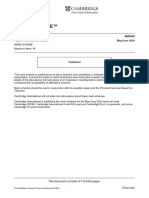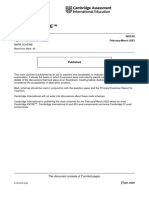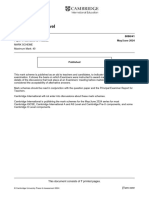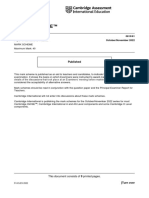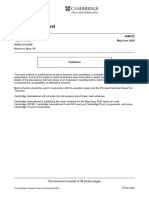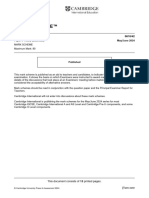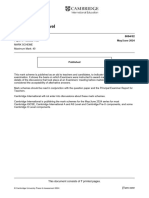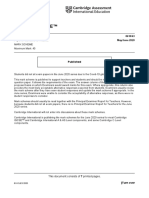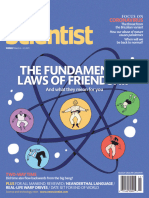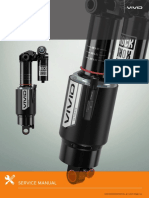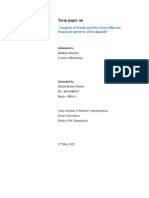Cambridge IGCSE™: Combined Science 0653/62
Cambridge IGCSE™: Combined Science 0653/62
Uploaded by
arindams.soodCopyright:
Available Formats
Cambridge IGCSE™: Combined Science 0653/62
Cambridge IGCSE™: Combined Science 0653/62
Uploaded by
arindams.soodOriginal Title
Copyright
Available Formats
Share this document
Did you find this document useful?
Is this content inappropriate?
Copyright:
Available Formats
Cambridge IGCSE™: Combined Science 0653/62
Cambridge IGCSE™: Combined Science 0653/62
Uploaded by
arindams.soodCopyright:
Available Formats
Cambridge IGCSE™
COMBINED SCIENCE 0653/62
Paper 6 Alternative to Practical May/June 2024
MARK SCHEME
Maximum Mark: 40
Published
This mark scheme is published as an aid to teachers and candidates, to indicate the requirements of the
examination. It shows the basis on which Examiners were instructed to award marks. It does not indicate the
details of the discussions that took place at an Examiners’ meeting before marking began, which would have
considered the acceptability of alternative answers.
Mark schemes should be read in conjunction with the question paper and the Principal Examiner Report for
Teachers.
Cambridge International will not enter into discussions about these mark schemes.
Cambridge International is publishing the mark schemes for the May/June 2024 series for most
Cambridge IGCSE, Cambridge International A and AS Level and Cambridge Pre-U components, and some
Cambridge O Level components.
This document consists of 8 printed pages.
© Cambridge University Press & Assessment 2024 [Turn over
0653/62 Cambridge IGCSE – Mark Scheme May/June 2024
PUBLISHED
Generic Marking Principles
These general marking principles must be applied by all examiners when marking candidate answers. They should be applied alongside the
specific content of the mark scheme or generic level descriptions for a question. Each question paper and mark scheme will also comply with these
marking principles.
GENERIC MARKING PRINCIPLE 1:
Marks must be awarded in line with:
the specific content of the mark scheme or the generic level descriptors for the question
the specific skills defined in the mark scheme or in the generic level descriptors for the question
the standard of response required by a candidate as exemplified by the standardisation scripts.
GENERIC MARKING PRINCIPLE 2:
Marks awarded are always whole marks (not half marks, or other fractions).
GENERIC MARKING PRINCIPLE 3:
Marks must be awarded positively:
marks are awarded for correct / valid answers, as defined in the mark scheme. However, credit is given for valid answers which go beyond
the scope of the syllabus and mark scheme, referring to your Team Leader as appropriate
marks are awarded when candidates clearly demonstrate what they know and can do
marks are not deducted for errors
marks are not deducted for omissions
answers should only be judged on the quality of spelling, punctuation and grammar when these features are specifically assessed by the
question as indicated by the mark scheme. The meaning, however, should be unambiguous.
GENERIC MARKING PRINCIPLE 4:
Rules must be applied consistently, e.g. in situations where candidates have not followed instructions or in the application of generic level
descriptors.
© Cambridge University Press & Assessment 2024 Page 2 of 8
0653/62 Cambridge IGCSE – Mark Scheme May/June 2024
PUBLISHED
GENERIC MARKING PRINCIPLE 5:
Marks should be awarded using the full range of marks defined in the mark scheme for the question (however; the use of the full mark range may
be limited according to the quality of the candidate responses seen).
GENERIC MARKING PRINCIPLE 6:
Marks awarded are based solely on the requirements as defined in the mark scheme. Marks should not be awarded with grade thresholds or
grade descriptors in mind.
Science-Specific Marking Principles
1 Examiners should consider the context and scientific use of any keywords when awarding marks. Although keywords may be present, marks
should not be awarded if the keywords are used incorrectly.
2 The examiner should not choose between contradictory statements given in the same question part, and credit should not be awarded for
any correct statement that is contradicted within the same question part. Wrong science that is irrelevant to the question should be ignored.
3 Although spellings do not have to be correct, spellings of syllabus terms must allow for clear and unambiguous separation from other
syllabus terms with which they may be confused (e.g. ethane / ethene, glucagon / glycogen, refraction / reflection).
4 The error carried forward (ecf) principle should be applied, where appropriate. If an incorrect answer is subsequently used in a scientifically
correct way, the candidate should be awarded these subsequent marking points. Further guidance will be included in the mark scheme
where necessary and any exceptions to this general principle will be noted.
5 ‘List rule’ guidance
For questions that require n responses (e.g. State two reasons …):
The response should be read as continuous prose, even when numbered answer spaces are provided.
Any response marked ignore in the mark scheme should not count towards n.
Incorrect responses should not be awarded credit but will still count towards n.
Read the entire response to check for any responses that contradict those that would otherwise be credited. Credit should not be
awarded for any responses that are contradicted within the rest of the response. Where two responses contradict one another, this
should be treated as a single incorrect response.
Non-contradictory responses after the first n responses may be ignored even if they include incorrect science.
© Cambridge University Press & Assessment 2024 Page 3 of 8
0653/62 Cambridge IGCSE – Mark Scheme May/June 2024
PUBLISHED
6 Calculation specific guidance
Correct answers to calculations should be given full credit even if there is no working or incorrect working, unless the question states ‘show
your working’.
For questions in which the number of significant figures required is not stated, credit should be awarded for correct answers when rounded
by the examiner to the number of significant figures given in the mark scheme. This may not apply to measured values.
For answers given in standard form (e.g. a 10n) in which the convention of restricting the value of the coefficient (a) to a value between 1
and 10 is not followed, credit may still be awarded if the answer can be converted to the answer given in the mark scheme.
Unless a separate mark is given for a unit, a missing or incorrect unit will normally mean that the final calculation mark is not awarded.
Exceptions to this general principle will be noted in the mark scheme.
7 Guidance for chemical equations
Multiples / fractions of coefficients used in chemical equations are acceptable unless stated otherwise in the mark scheme.
State symbols given in an equation should be ignored unless asked for in the question or stated otherwise in the mark scheme.
© Cambridge University Press & Assessment 2024 Page 4 of 8
0653/62 Cambridge IGCSE – Mark Scheme May/June 2024
PUBLISHED
Question Answer Marks
1(a)(i) all results recorded in mm ; 2
all results correct (expect 0, 5, 12, 20, 44) 1 mm ;
1(a)(ii) any one from: 1
height of liquid varies ;
peas displace hydrogen peroxide ;
only want to measure bubbles ;
1(a)(iii) vertical axis labelled height or h in mm AND horizontal axis labelled number of peas ; 3
linear scales so that plotted points occupy at least half the grid ;
plots correct to ½ small square ;
1(a)(iv) line of best fit ; 1
1(a)(v) correct estimate from graph ; 2
horizontal and vertical lines shown on graph ;
1(a)(vi) as the (number of) peas increases, the height (of bubbles) increases ; 1
1(a)(vii) the higher the concentration of catalase, the higher the rate of breakdown of hydrogen peroxide ; 1
1(b) difficult to determine exact height / bubbles not level ; 1
1(c) can identify / check for / exclude, anomalous results ; 1
© Cambridge University Press & Assessment 2024 Page 5 of 8
0653/62 Cambridge IGCSE – Mark Scheme May/June 2024
PUBLISHED
Question Answer Marks
2(a)(i) mixture of colours seen (blue-green and yellow) / (green-blue) colour only appears for a short time ; 1
2(a)(ii) yellow colour will mask the flame colour / yellow flame is not as hot as the blue flame ; 1
2(b) allows the precipitate to sink to the bottom of the test-tube / filters the mixture (to see colour of residue) ; 1
2(c) chloride ; 2
test 3 / (dilute) nitric acid and (aqueous) silver nitrate ;
2(d) (light) blue precipitate ; 2
(with excess) dark blue solution ;
© Cambridge University Press & Assessment 2024 Page 6 of 8
0653/62 Cambridge IGCSE – Mark Scheme May/June 2024
PUBLISHED
Question Answer Marks
3 One mark from each section and any two other marking points: 7
(If one section is missing max 6 etc.)
1 Apparatus
balance AND measuring cylinder ;
stop-clock ;
2 Method
description of making different concentrations of salt solution ;
leave different concentrations of salt solution to evaporate for a fixed time (not to dryness / crystallisation) ;
at least five different concentrations of salt solution ;
3 Measurements
states values of mass of salt added to make solutions (if they use increments, must include the starting mass) / states
volumes used in serial dilution ;
measure mass / volume of salt solution at start and at end ;
measure time (for fixed change in, mass / volume) ;
4 Control variables
temperature of liquid or room ;
(initial) volume of salt solution ;
5 Processing results
calculate rate / divide mass by time ;
plot a graph of change of mass against concentration of salt solution / graph of time for fixed change in mass against
concentration of salt solution / graph of rate against concentration ;
idea of repeat measurements at each concentration and averaging results / repeat measurements at each concentration to,
identify / check for / exclude anomalous results ;
© Cambridge University Press & Assessment 2024 Page 7 of 8
0653/62 Cambridge IGCSE – Mark Scheme May/June 2024
PUBLISHED
Question Answer Marks
4(a)(i) 78.5 ; 2
76.0 ;
4(a)(ii) 77.0 (indicated) ; 1
4(b)(i) ( A) 15.0 and ( B) 9.0 ; 1
4(b)(ii) RA = 0.08(333 …) and RB = 0.05(0) ; 3
both recorded to 2 sf (0.083 and 0.050) ;
unit = °C / s ;
4(b)(iii) statement must be consistent with candidate results 2
expect
rates are different (no mark)
evidence of 10% calculation ;
because they differ by more than 10% / are not within experimental accuracy ;
OR
rates are the same (no mark)
evidence of 10% calculation ;
because they are within 10% of each other / are within experimental accuracy ;
4(c)(i) read (with eye) perpendicular (to the reading) ; 1
4(c)(ii) measuring cylinder ; 1
4(c)(iii) any two from: 2
same starting temperature of water (in both beakers) ;
stir the water before each temperature reading ;
© Cambridge University Press & Assessment 2024 Page 8 of 8
You might also like
- Cambridge IGCSE ™: Biology 0610/32Document12 pagesCambridge IGCSE ™: Biology 0610/32cbmapongaNo ratings yet
- Cambridge O Level: Biology 5090/42Document9 pagesCambridge O Level: Biology 5090/42afsheen24akramNo ratings yet
- 0625 M24 Mark SchemeDocument8 pages0625 M24 Mark SchemeShivansh SarkarNo ratings yet
- Screenshot 2024-10-03 at 4.18.20 PMDocument8 pagesScreenshot 2024-10-03 at 4.18.20 PMKhurram AwanNo ratings yet
- Cambridge IGCSE™: Biology 0610/63Document9 pagesCambridge IGCSE™: Biology 0610/63wahajmohammed51No ratings yet
- Cambridge International AS & A Level: Biology 9700/43 May/June 2022Document23 pagesCambridge International AS & A Level: Biology 9700/43 May/June 2022Aneeqa KhanNo ratings yet
- Cambridge IGCSE ™: Physics 0625/52Document8 pagesCambridge IGCSE ™: Physics 0625/52张查No ratings yet
- Cambridge IGCSE ™: Biology 0610/52Document9 pagesCambridge IGCSE ™: Biology 0610/52AHMADNo ratings yet
- Cambridge IGCSE™: Chemistry 0620/63Document7 pagesCambridge IGCSE™: Chemistry 0620/63rastogivedant2009No ratings yet
- Cambridge IGCSE™: Combined Science 0653/62 February/March 2022Document8 pagesCambridge IGCSE™: Combined Science 0653/62 February/March 2022jesslynaureliaNo ratings yet
- Cambridge IGCSE™: Biology 0610/62 May/June 2022Document8 pagesCambridge IGCSE™: Biology 0610/62 May/June 2022walsha khanNo ratings yet
- Cambridge O Level: Physics 5054/42Document9 pagesCambridge O Level: Physics 5054/42Rithika HimathNo ratings yet
- Cambridge O Level: Biology 5090/32Document8 pagesCambridge O Level: Biology 5090/32breshnaimran321No ratings yet
- paper 32 msDocument10 pagespaper 32 msdhritikapadia747No ratings yet
- Cambridge IGCSE ™: Combined ScienceDocument7 pagesCambridge IGCSE ™: Combined SciencejesslynaureliaNo ratings yet
- Ans Paper 6Document7 pagesAns Paper 6suhaankochhar2008No ratings yet
- Cambridge International AS & A Level: Biology 9700/34 May/June 2022Document8 pagesCambridge International AS & A Level: Biology 9700/34 May/June 2022mariakhan.educationNo ratings yet
- Cambridge IGCSE ™: Biology 0610/41Document12 pagesCambridge IGCSE ™: Biology 0610/41shabanaNo ratings yet
- Mark SchemeDocument10 pagesMark Scheme12310-214No ratings yet
- Cambridge IGCSE™: Combined Science 0653/62 March 2020Document8 pagesCambridge IGCSE™: Combined Science 0653/62 March 2020Hin Wa LeungNo ratings yet
- 0610 m22 Ms 42 PDFDocument12 pages0610 m22 Ms 42 PDFdavin tejaNo ratings yet
- Cambridge International AS & A Level: Biology 9700/33Document6 pagesCambridge International AS & A Level: Biology 9700/33张查No ratings yet
- Cambridge IGCSE™: Combined Science 0653/52 March 2020Document8 pagesCambridge IGCSE™: Combined Science 0653/52 March 2020Hin Wa LeungNo ratings yet
- Cambridge O Level: Biology 5090/41Document7 pagesCambridge O Level: Biology 5090/41Mohummed IbraheemNo ratings yet
- Cambridge IGCSE™: Chemistry 0620/31Document10 pagesCambridge IGCSE™: Chemistry 0620/31wokoba7588No ratings yet
- Cambridge O Level: Biology 5090/42Document8 pagesCambridge O Level: Biology 5090/42breshnaimran321No ratings yet
- Cambridge O Level: Chemistry 5070/41 May/June 2022Document10 pagesCambridge O Level: Chemistry 5070/41 May/June 2022Saeed RehmanNo ratings yet
- Cambridge IGCSE™: Physics 0625/53Document9 pagesCambridge IGCSE™: Physics 0625/53ccbpxprwd2No ratings yet
- Cambridge IGCSE ™: Biology 0610/61 October/November 2022Document9 pagesCambridge IGCSE ™: Biology 0610/61 October/November 2022ramloghun veerNo ratings yet
- Cambridge IGCSE ™: Co-Ordinated SciencesDocument14 pagesCambridge IGCSE ™: Co-Ordinated SciencesKhoa DangNo ratings yet
- Cambridge O Level: Biology 5090/22Document10 pagesCambridge O Level: Biology 5090/22breshnaimran321No ratings yet
- Cambridge IGCSE™: Biology 0610/42Document13 pagesCambridge IGCSE™: Biology 0610/42Wajd AlrawashdehNo ratings yet
- 9702_s24_ms_52Document10 pages9702_s24_ms_52Abdulrehman Ahmed FadulNo ratings yet
- Cambridge IGCSE ™: Biology 0610/63 October/November 2022Document8 pagesCambridge IGCSE ™: Biology 0610/63 October/November 2022ramloghun veerNo ratings yet
- Cambridge IGCSE™: Biology 0610/63Document8 pagesCambridge IGCSE™: Biology 0610/63manar mohamedNo ratings yet
- Cambridge IGCSE™: Combined Science 0653/63 May/June 2020Document7 pagesCambridge IGCSE™: Combined Science 0653/63 May/June 2020Hin Wa LeungNo ratings yet
- Cambridge IGCSE™: Biology 0610/61 May/June 2022Document9 pagesCambridge IGCSE™: Biology 0610/61 May/June 2022Bashir SsekalegaNo ratings yet
- Cambridge IGCSE ™: BiologyDocument12 pagesCambridge IGCSE ™: BiologyTom TommmaNo ratings yet
- Cambridge IGCSE™: Biology 0610/31Document11 pagesCambridge IGCSE™: Biology 0610/31bocciamercedesNo ratings yet
- Cambridge International AS & A Level: Physical Education 9396/12 October/November 2022Document14 pagesCambridge International AS & A Level: Physical Education 9396/12 October/November 2022tanakaclementeNo ratings yet
- 2025 Specimen Paper 5 Mark SchemeDocument10 pages2025 Specimen Paper 5 Mark SchemeIsnaini Rohayati, M.Pd.No ratings yet
- Cambridge O Level: Physics 5054/32Document7 pagesCambridge O Level: Physics 5054/32breshnaimran321No ratings yet
- Cambridge IGCSE™: Combined Science 0653/61 May/June 2020Document7 pagesCambridge IGCSE™: Combined Science 0653/61 May/June 2020Hin Wa LeungNo ratings yet
- 0610 m22 Ms 32 PDFDocument11 pages0610 m22 Ms 32 PDFsolihinNo ratings yet
- 0653_m23_ms_62Document7 pages0653_m23_ms_62farah.abed07No ratings yet
- Cambridge IGCSE™: Biology 0610/42 February/March 2022Document12 pagesCambridge IGCSE™: Biology 0610/42 February/March 2022bali yunNo ratings yet
- Cambridge IGCSE™: Chemistry 0620/53 May/June 2020Document7 pagesCambridge IGCSE™: Chemistry 0620/53 May/June 2020Diah SantyNo ratings yet
- Cambridge IGCSE ™: BiologyDocument12 pagesCambridge IGCSE ™: BiologyAhmed TarekNo ratings yet
- Cambridge International AS & A Level: Biology 9700/31Document9 pagesCambridge International AS & A Level: Biology 9700/31kshitizshresthaNo ratings yet
- Cambridge O Level: Biology 5090/61 May/June 2021Document7 pagesCambridge O Level: Biology 5090/61 May/June 2021Sasaki MeraNo ratings yet
- Cambridge International AS & A Level: Biology 9700/22Document13 pagesCambridge International AS & A Level: Biology 9700/22张查No ratings yet
- Cambridge IGCSE™: Biology 0610/63 May/June 2020Document7 pagesCambridge IGCSE™: Biology 0610/63 May/June 2020bali yunNo ratings yet
- Cambridge IGCSE ™: BiologyDocument7 pagesCambridge IGCSE ™: BiologyTom TommmaNo ratings yet
- Cambridge International AS & A Level: Biology 9700/42Document21 pagesCambridge International AS & A Level: Biology 9700/42Tamer AhmedNo ratings yet
- Cambridge IGCSE™: Biology 0610/53 May/June 2021Document7 pagesCambridge IGCSE™: Biology 0610/53 May/June 2021Irvine MupambaNo ratings yet
- Cambridge International AS & A Level: Biology 9700/23 May/June 2020Document15 pagesCambridge International AS & A Level: Biology 9700/23 May/June 2020Mohamed HNo ratings yet
- Cambridge International AS & A Level: Biology 9700/32Document9 pagesCambridge International AS & A Level: Biology 9700/32LongNo ratings yet
- Cambridge IGCSE ™: BiologyDocument10 pagesCambridge IGCSE ™: BiologyTom TommmaNo ratings yet
- 0610 w23 Ms 52pracigcseDocument8 pages0610 w23 Ms 52pracigcsedesrescottNo ratings yet
- Bullying SpeechDocument2 pagesBullying SpeechRaudhatul jannahNo ratings yet
- Infineon-1 WhitePaper How GaN On Si Can Help Deliver Higher Efficiencies in Power Conversion and Power Management en-Whitepaper-V02 00-EnDocument13 pagesInfineon-1 WhitePaper How GaN On Si Can Help Deliver Higher Efficiencies in Power Conversion and Power Management en-Whitepaper-V02 00-Enar.haidari02No ratings yet
- Review For Basic Math Skills Final Exam: Page 1 of 16Document16 pagesReview For Basic Math Skills Final Exam: Page 1 of 16Nayem Hossain HemuNo ratings yet
- HELP DESK FAQ 1 Troubleshooting RTD Problems v1.1 PDFDocument2 pagesHELP DESK FAQ 1 Troubleshooting RTD Problems v1.1 PDFLh KooNo ratings yet
- G Drive Engines Weichai Oman MuscatDocument14 pagesG Drive Engines Weichai Oman MuscatmustafaNo ratings yet
- A400SM A400XLR A400SMXLR A99SMA-user-guideDocument4 pagesA400SM A400XLR A400SMXLR A99SMA-user-guidene0botNo ratings yet
- A Study On Employee Satisfaction Towards Welfare Measures in Bhel-Heavy Plates&Vessels Plant, VisakhapatnamDocument14 pagesA Study On Employee Satisfaction Towards Welfare Measures in Bhel-Heavy Plates&Vessels Plant, Visakhapatnamseelam manoj sai kumarNo ratings yet
- Human Resource Management: Prof. Zenaida F. JesalvaDocument18 pagesHuman Resource Management: Prof. Zenaida F. JesalvaJoyce Ann Contreras ReyesNo ratings yet
- World Literature: Theories in The Context of GlobalizationDocument1 pageWorld Literature: Theories in The Context of GlobalizationAna Lei Za ErtsivelNo ratings yet
- New Scientist, No. 3324 (2021-03-06)Document60 pagesNew Scientist, No. 3324 (2021-03-06)Neph IllimNo ratings yet
- Hand Hygiene Lesson Plan and Resources KS2 2020Document21 pagesHand Hygiene Lesson Plan and Resources KS2 2020anbyvarghese007No ratings yet
- Half Million SecretsDocument2 pagesHalf Million SecretsmaNo ratings yet
- Energy EfficiencyDocument125 pagesEnergy EfficiencyJ Soren100% (1)
- The Perfect Way To Start An EmailDocument19 pagesThe Perfect Way To Start An EmailrubliovdetarkovskiNo ratings yet
- Camless Engine PresentationDocument26 pagesCamless Engine PresentationAyush BanerjeeNo ratings yet
- PT - Science 5 - Q4Document7 pagesPT - Science 5 - Q4Ellen Joy GulamNo ratings yet
- Leadership Experience Jose GomezDocument4 pagesLeadership Experience Jose Gomezapi-316654176No ratings yet
- Engexam - info-CAE Reading and Use of English Practice Test 6 PrintableDocument3 pagesEngexam - info-CAE Reading and Use of English Practice Test 6 PrintableBobo StoyanovNo ratings yet
- FDA Class Term 2Document45 pagesFDA Class Term 2Arghya BoseNo ratings yet
- 2024 Vivid Service ManualDocument113 pages2024 Vivid Service ManualZbyněk SyptákNo ratings yet
- Brand Management Term Paper (Shafiul Bashar Shanto)Document18 pagesBrand Management Term Paper (Shafiul Bashar Shanto)Bashar ShantoNo ratings yet
- Tutorial 4Document6 pagesTutorial 4Pratik Babu GhimireNo ratings yet
- Industrial Electronics Lab Manual UOCDocument81 pagesIndustrial Electronics Lab Manual UOCImran ShaukatNo ratings yet
- Lampiran 10 - Hasil Uji ValiditasDocument4 pagesLampiran 10 - Hasil Uji ValiditasIrfan Al Ma'rufNo ratings yet
- Tung (Violence Ritual and The Wari Empire A Social Bioarchaeology of Imperialism in The Ancient Andes 2012) PDFDocument271 pagesTung (Violence Ritual and The Wari Empire A Social Bioarchaeology of Imperialism in The Ancient Andes 2012) PDFRUBEN SANCHEZ50% (2)
- Aruna - ResumeDocument7 pagesAruna - Resumemiss_jyoti_kapoorNo ratings yet
- Hydrogen, Compressed Safety Data Sheet P-4604Document10 pagesHydrogen, Compressed Safety Data Sheet P-4604Evans Azka FNo ratings yet
- Lunar Topography LabDocument5 pagesLunar Topography LabMarcus CasillasNo ratings yet
- Interfacial Transition Zone in Concrete: Review ArticleDocument9 pagesInterfacial Transition Zone in Concrete: Review ArticlearunNo ratings yet
- Notes and Learning Based On Reading and Reviewing LiteratureDocument4 pagesNotes and Learning Based On Reading and Reviewing LiteraturepannapurohitNo ratings yet








